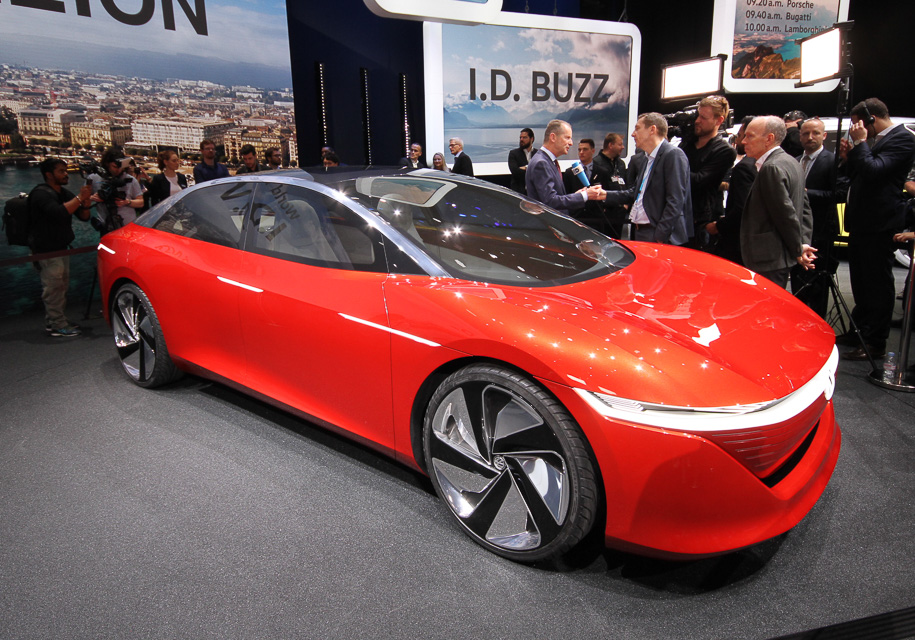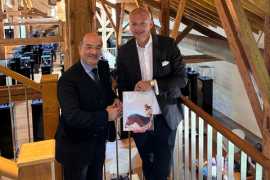Geneva Motor Show: Five concept cars driving auto industry into future
By Aliheydar_Rzayev Sunday, 18 March 2018 2:22 AM

The Geneva Motor Show (8 – 18 March 2018) is quite simply the best place in the world to see the widest range of concept cars. From the big players to the small, this year’s event included all manner of electrified and sportscars, saloons and coupes – plus two flying cars – one of which is slated to be less than 12 months away from final customer delivery.
These weird and wonderful machines, heralding the future of the automotive industry, are always crowd-pleasers at the Geneva Motor Show.

Porsche Mission E Cross Turismo
With this new fully electric crossover concept, Porsche debuts innovative display and operating technology with touchscreen and eye-tracking control.
A camera in the rear-view mirror detects what the driver is looking at, such as specific onboard instruments, then displays whatever the driver is interested in on a head-up display optimally positioned in the driver's field of vision.

Volkswagen ID Vizzion
The Volkswagen ID Vizzion electric and autonomous sedan puts artificial intelligence to use in the automotive industry. In the future, this technology will allow the vehicle to analyze and interpret the many types of situations encountered on the road.
The ID Vizzion already uses facial recognition to prevent unauthorized users from taking the controls (gestures and voice commands). Moreover, level-five autonomous driving, for fully driverless mobility, allows each passenger to make full use of their time onboard.
The ID Vizzion “open space” interior proposes a customizable cabin, ensuring the wellbeing of all vehicle passengers.

Audi Pop.Up Next
VW Group’s Italdesign and Airbus added seriousness to the flying car race at the 2017 Geneva Motor Show with their Pop.Up all-electric part-car, part-drone modular concept. At 2018’s Geneva show the Pop.Up Next – now with added Audi – aims to make clear that the big-hitting companies are still taking the idea of a connected, hail-and-ride, eco-friendly, congestion-busting fly/drive future vehicle seriously. The two-seater has been made more aerodynamic, lighter and a bit more stylish – enough to warrant Audi adding its four rings to the nose – and Italdesign and Airbus’s engineers have improved the coupling and de-coupling systems between the car and flying modules. Although smarter in every sense then, the electric city commuter concept still only offers a 30-mile range and could be 5-10 years away from being production- and cost-viable.

Aston Martin Lagonda Vision Concept
The future of Aston Martin's premium brand Lagonda will lie in electric and autonomous vehicles. With the Lagonda Vision Concept, the British carmaker showcases its vision of luxury mobility.
Onboard, passengers can pivot their seats to create a cozy, social atmosphere surrounded by prestige materials like carbon and cashmere. Two production Lagonda models inspired by the concept could materialise by 2023.

Renault EZ-GO
The Renault EZ-Go didn't go unnoticed at the Swiss show. Described by the carmaker as a "robo-vehicle," it is designed for public or private transportation in urban environments.
Essentially a connected and autonomous car-sharing concept, the vehicle is designed to simplify urban travel, offering a stress-free and comfortable solution. Speed is limited to 50kph. It is the first in a series of concept cars Renault has in store for 2018.
![]()
Icona Nucleus
The Icona is a name you’ve probably not have heard of because it’s not a car brand but a design business – based in Turin, Shanghai and now California – that creates cars for other brands to produce. The group chose Geneva to reveal its 600hp in-wheel-electric Nucleus concept. Pitched as a ‘Level 5-autonomous’ vehicle – one that can drive itself in all situations – the Nucleus was born from the ‘idea of a car that you will still love and want to own, despite autonomy’ in a retort to the notion that all future cars will merely be hired as necessary.
It’s big: 5.25m long, 2.12m wide, 1.75m high and riding on 27” wheels with a 3.3m wheelbase, those dimensions allow for a huge interior space for up to six people.
The other striking element of the design is the lack of conventional glass windows – there’s no driver so no need for a front windscreen, and occupants can look out the sides through semi-transparent body colour panels that allow for privacy from the outside. Considerable time was spent on a well-resolved human machine interface too, which works like a more intuitive Uber app, requesting user interests as well as destination info to curate a more tailored journey, that might for instance, suggest restaurants and other points of interest along the way based on your daily preferences. Despite its two-tonne weight, grand-tourer flexibility is promised via a hydrogen-powered range-extender good for circa 750 miles of travel… in about 2030.




























Add new comment